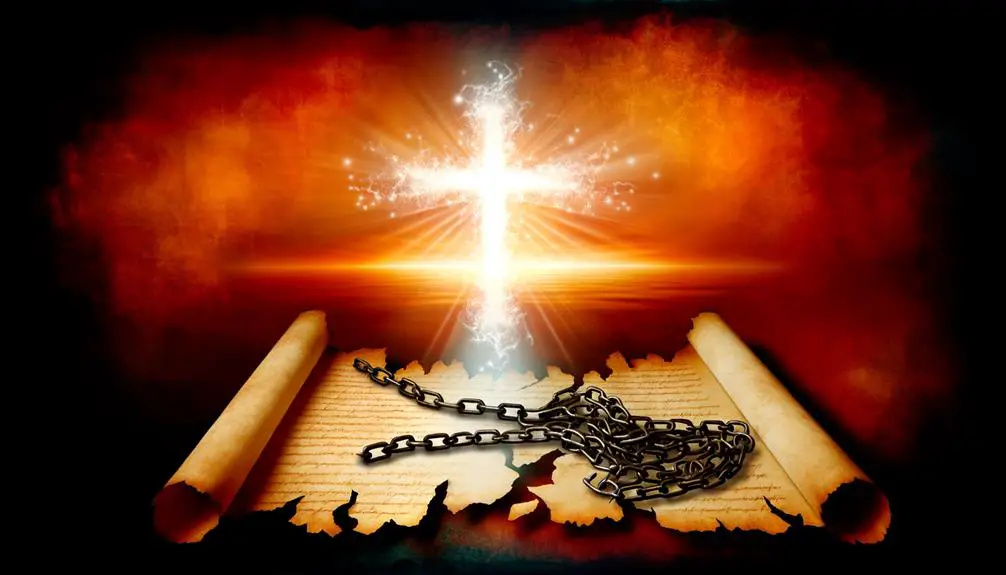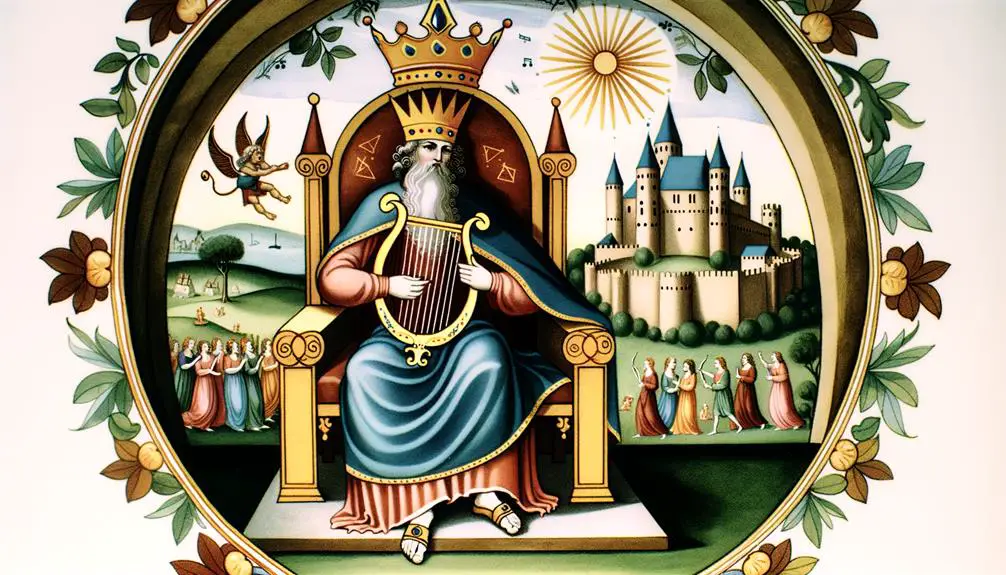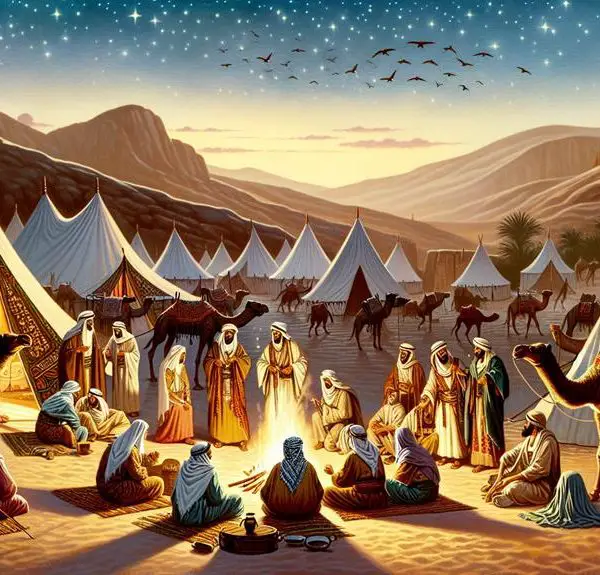Uncover the richness of 'R' in the Bible, from Ruth to Revelation, and embark on a journey of discovery, faith, and transformation.

R in the Bible
Navigating the Bible, you'll find that the letter 'R' stands as a gateway to a treasure trove of stories and teachings. From the resilience of Ruth to the remarkable story of Rahab's faith, these narratives offer profound insights into the human and divine.
They weave through the concepts of resurrection, redemption, and the reigns of kings, highlighting the importance of repentance and the revelations that unfold. Each one, like a thread in a larger tapestry, invites you to explore deeper, urging you to uncover how these themes resonate within your own life and the broader human experience.
Key Takeaways
- Ruth exemplifies loyalty and divine providence, illustrating the power of faith and redemption in biblical narratives.
- Rahab's story highlights the transformative impact of faith, showcasing her inclusion in Jesus' lineage as a testament to divine grace.
- The concept of resurrection and redemption underscores the promise of salvation and eternal life through faith in Christianity.
- Apocalyptic imagery, including the Seven Seals in Revelation, offers deep insights into divine judgment and the ultimate triumph of good over evil.
The Role of Ruth

In the biblical narrative, Ruth emerges as a pivotal figure, exemplifying unwavering loyalty and the transformative power of redemption within a complex social and religious landscape. You'll find her story intricately woven with themes of devotion, societal integration, and divine providence, rooted deeply in her Moabite lineage and the cultural backdrop of the harvest festival.
As a Moabite, Ruth's integration into the Israelite community underscores the broader theme of inclusivity and the breaking down of ethnic barriers within the sacred text. Her decision to cling to Naomi, her Israelite mother-in-law, and 'where you go, I'll go' commitment not only highlights her personal loyalty but also symbolizes the potential for unity and acceptance across divergent cultures and traditions. It's this aspect of her character that challenges you to reconsider notions of outsider versus insider within a faith community.
The harvest festival backdrop serves as a rich symbolic canvas, illustrating themes of providence, renewal, and the cyclical nature of life and faith. Ruth's active participation in gleaning the fields during this festival not only reflects her humble willingness to work but also places her in the path of Boaz, her future husband, setting the stage for her eventual integration into the lineage of David and, ultimately, Jesus. This progression from outsider to integral community member through her actions during the harvest underscores the narrative's emphasis on redemption and the idea that faithfulness and virtue can transcend cultural and ethnic boundaries.
Analyzing Ruth's story, you're invited to reflect on the enduring themes of loyalty, redemption, and the inclusive heart of divine love, all while navigating the complexities of her Moabite heritage and the seasonal rhythms of ancient agricultural life.
Rahab's Story of Faith

Shifting focus to another remarkable woman in the biblical narrative, Rahab's story unfolds a compelling account of faith, courage, and redemption against the backdrop of Jericho's fall. You'll find her narrative deeply intertwined with the destiny of the Israelites, as her actions directly influence the outcome of Jericho's siege.
Rahab, a resident of Jericho, makes a life-altering decision by harboring two Israelite spies sent by Joshua. This act of faith and allegiance to a God she wasn't raised to worship is striking. It's not just the protection of the spies that stands out, but her insightful recognition of the Israelites' God as the supreme deity, deserving of her allegiance.
Her story isn't just about the act of hiding spies; it's about making a covenant for protection. Rahab's negotiation skills ensure not just her survival, but her family's as well, marking a pivotal moment in the biblical account of faith and redemption.
Aspect |
Impact |
|---|---|
Faith |
Rahab's belief in God, despite her background, showcases a profound personal transformation. |
Courage |
Her decision to hide the spies under the risk of death exemplifies unparalleled bravery. |
Negotiation |
Securing her and her family's safety illustrates foresight and wisdom. |
Redemption |
Rahab's inclusion in the lineage of Jesus highlights the redemptive power of faith. |
Legacy |
Her story is a testament to the belief that anyone's faith can alter their destiny. |
Rahab's narrative teaches that faith in God can break barriers and change destinies, transcending one's past or social standing. Her story of faith, interwoven with Jericho's fall and the spies' protection, remains a powerful testament to redemption and courage.
Resurrection in Christian Belief

Central to Christian doctrine, the resurrection represents a cornerstone belief that Jesus Christ rose from the dead, affirming the power of God over life and death. This event isn't only pivotal but also serves as the very foundation upon which the Christian faith is built. It's a historical and theological anchor that provides profound implications for understanding the nature of God, the reality of life after death, and the potential for human redemption and transformation.
The significance of Easter, which commemorates the resurrection, can't be overstated. It's a period of profound reflection, joy, and renewal for believers worldwide. Easter encapsulates the victory of life over death, embodying the promise of eternal life for those who believe in Jesus Christ. This celebration reinforces the belief in the triumph of good over evil and the hope that comes with the assurance of salvation.
Moreover, the miracle of Lazarus, as recounted in the Gospel of John, prefigures the resurrection of Jesus and underscores the authority of Christ over death. This miraculous event serves as a tangible demonstration of the power of God and a precursor to the greater miracle of Easter. It reinforces the message that death doesn't have the final say and that through faith in Christ, resurrection and life are assured.
In analyzing the resurrection, it's essential to consider its far-reaching implications for Christian theology and personal faith. It affirms the deity of Jesus, validates the truth of Scripture, and offers a beacon of hope for eternal life beyond the grave. The resurrection stands as a testament to the power of God, inviting believers to live in the light of this transformative truth.
The Concept of Redemption

You'll find the concept of redemption woven throughout the biblical narrative, serving as a cornerstone for understanding divine grace and human salvation.
It's essential to explore its meaning, observe its manifestation in scripture, and consider its relevance in contemporary faith practices.
This approach allows us to grasp the transformative power of redemption, both historically and in modern contexts.
Meaning of Redemption
In biblical terms, redemption signifies the act of God's deliverance of His people from bondage and sin, encompassing both a historical deliverance and a spiritual salvation. This concept is deeply rooted in understanding sin's cost and the intricate forgiveness process. Redemption isn't merely a theological abstraction but a transformative experience that impacts both the individual and the collective faith community.
To delve deeper:
- Sin's Cost: Acknowledges the profound impact of sin, separating humanity from God.
- Forgiveness Process: Outlines the steps towards reconciliation with God, emphasizing repentance and divine mercy.
- Transformative Experience: Highlights the personal and communal change that follows redemption, fostering a deeper relationship with God and a renewed sense of purpose.
This multifaceted concept invites you to explore the depths of God's grace and the profound impact of His redemptive work in the world.
Examples in Scripture
Throughout the Bible, various narratives exemplify the concept of redemption, illustrating how God's deliverance unfolds in both grand historical events and individual lives. Rebekah's Choice, for instance, showcases personal redemption through her decisive actions that align with God's will, paving the way for the establishment of Israel. This narrative underscores the individual's role in God's redemptive plan.
Rachel's Tears, on the other hand, represent a collective yearning for redemption, symbolizing Israel's suffering and hope for deliverance. These stories, rooted in historical and theological context, highlight the multifaceted nature of redemption. They reveal a God who's intimately involved in the redemption of both nations and individuals, weaving a complex tapestry of deliverance that spans the entirety of Scripture.
Redemption's Impact Today
Today, the concept of redemption remains as relevant as ever, shaping our understanding of spirituality, community, and personal transformation. This timeless principle carries profound modern applications and societal implications that echo through various aspects of life. You'll find its influence manifest in:
- Personal Growth: Individuals draw on redemption's promise for overcoming past mistakes and fostering self-improvement.
- Social Justice: Communities leverage the concept to advocate for systemic changes, emphasizing forgiveness and second chances.
- Cultural Narratives: Stories and media frequently explore redemption arcs, reflecting society's enduring fascination with the idea.
The analytical examination of redemption today reveals a multifaceted impact, illuminating its role in guiding ethical behavior, nurturing social cohesion, and inspiring collective and individual progress. Through this lens, redemption's relevance isn't just historical but deeply entrenched in the fabric of contemporary life.
Revelations: Prophecy and Symbolism

You'll find that the Book of Revelation stands as a complex tapestry of prophecy and symbolism, demanding nuanced interpretation. Understanding apocalyptic imagery requires a thorough grasp of its historical and theological context.
Interpreting the Seven Seals, in particular, unveils layers of meaning regarding divine judgment and eschatological hope in the Christian faith.
Understanding Apocalyptic Imagery
The Book of Revelation's apocalyptic imagery, rich in symbolism and prophetic visions, demands a nuanced understanding to grasp its complex messages about the end times. You'll find that this imagery isn't standalone; it's deeply rooted in the broader biblical tradition, notably in:
- Daniel's visions, which provide a foundation for apocalyptic literature with their own complex symbols and themes.
- Ezekiel's prophecies, offering imagery that Revelation later echoes and expands upon.
- The use of symbolic numbers and creatures, which often carry specific theological or eschatological significance.
Analyzing these elements within their historical and literary context is crucial. This approach helps unravel the layered meanings behind the vivid and sometimes perplexing visions presented in Revelation, offering insights into its prophetic messages about ultimate justice, the triumph of good over evil, and the hope of a new creation.
Interpreting Seven Seals
Delving into the Seven Seals of Revelation reveals a complex interplay of prophecy and symbolism, reflecting the intricate tapestry of apocalyptic literature. As you explore the Seal interpretations, you're engaging with a rich tradition of scholarly debate that seeks to understand these symbols within their historical context.
Each Seal, from the arrival of the Four Horsemen to the ensuing cataclysms, represents distinct facets of prophetic messages. Historians and theologians alike parse through ancient texts, trying to unravel how these apocalyptic visions related to the fears and hopes of early Christian communities.
This endeavor not only illuminates the past but also offers insights into how symbols of transformation and judgment have perennially shaped human understanding of divine intervention and ultimate destiny.
The Reign of King David

King David's reign marks a pivotal chapter in biblical history, characterized by strategic alliances, military conquests, and profound religious developments. You'll find that his path to kingship and the subsequent rule over Israel isn't just a tale of political ascendancy but also a narrative rich with spiritual and cultural undertones. Initially, David's harpistry, a symbol of his profound connection with God, and his victorious battle against Goliath, set the stage for his rise. These events not only underscore his divine favor but also his prowess as a leader and warrior.
During David's rule, several key developments stand out:
- Establishment of Jerusalem as the political and religious center: David's strategic relocation of the capital to Jerusalem solidified its significance in Jewish history.
- Expansion of Israel's borders through military campaigns: His leadership in battles facilitated the expansion of Israel, securing its place among the regional powers.
- Promotion of religious practices and the Ark of the Covenant: David brought the Ark to Jerusalem, emphasizing the city's spiritual importance and fostering a unified religious identity among the Israelites.
Analyzing David's reign, it's crucial to appreciate the complexity of his character and governance. His military strategies and diplomatic endeavors ensured Israel's security and prosperity. However, it's his deep spiritual engagement, exemplified by his psalms and devotion to God, that profoundly shaped the cultural and religious landscape of Israel. This period of biblical history, therefore, not only highlights the geopolitical shifts of the time but also reflects the intricate interplay between faith, leadership, and cultural identity.
Repentance in Biblical Teachings

How does the concept of repentance shape the moral and spiritual landscape of biblical teachings?
At its core, repentance is an acknowledgment of one's sinful nature and a deliberate turn towards a life aligned with divine principles. In the biblical context, it's not merely an admission of wrongdoing but an essential step towards divine forgiveness and spiritual renewal.
The narrative of repentance is deeply interwoven with the recognition of humanity's inherent sinful nature. This acknowledgment isn't meant to demean or condemn but to highlight the universal need for grace and redemption. The Bible portrays repentance as a courageous acceptance of one's flaws and a heartfelt commitment to transformation.
Divine forgiveness, as depicted in biblical teachings, isn't unconditional. It requires sincere repentance, a process that goes beyond superficial regret. True repentance involves a profound change of heart and mind, leading to a reorientation of one's life and actions. This dynamic process reflects a deep understanding of the gravity of sin and its repercussions, both spiritually and morally.
Moreover, repentance isn't a solitary journey. It's facilitated by a relationship with the divine, where guidance and strength are sought to overcome one's sinful inclinations. This divine-human interaction underscores the compassionate and forgiving nature of God, who desires reconciliation over condemnation.
Frequently Asked Questions
How Does the Use of the Letter 'R' in Biblical Names Reflect Cultural or Linguistic Significance in Ancient Times?
You're exploring how the letter 'r' in names reflects ancient cultural or linguistic significance. R's phonetics and regional variations play a crucial role.
This letter carries different weights and sounds across languages, hinting at diverse origins and influences in naming practices. It's not just about the sound; it's a window into historical interactions, migrations, and linguistic evolutions.
Analyzing these aspects offers a richer understanding of ancient societal structures and their communication methods.
Are There Any Hidden Meanings or Numerological Interpretations Associated With the Letter 'R' in Biblical Texts?
You might find it fascinating how certain letters carry deeper meanings beyond their simple appearance in texts. Specifically, the exploration into the letter 'r' reveals a rich tapestry of ritual significance and insights through resonance theory.
This analytical dive uncovers hidden dimensions within texts, suggesting that 'r' mightn't just be a letter but a key to unlocking nuanced interpretations and numerological connections, offering a scholarly, contextual analysis of its profound impact.
How Do Non-Canonical Texts or Apocryphal Writings Treat Subjects Beginning With the Letter 'R' Differently From the Canonical Bible?
You'll find that non-canonical texts often offer a unique take on topics like ritual purity and repentance narratives. These writings may diverge significantly from the canonical Bible, presenting alternative perspectives or emphasizing different aspects of these subjects.
In What Ways Have Modern Interpretations or Translations of the Bible Altered the Understanding of Concepts Starting With 'R'?
You've likely noticed how modern translations and interpretations of biblical texts have shifted our grasp of key concepts. Specifically, 'Resurrection narratives' and 'Redemption roles' have seen nuanced changes.
Scholars dig into language and cultural shifts, uncovering layers of meaning that were less spotlighted in past readings. This analytical approach reveals how evolving linguistic and theological perspectives influence our understanding, making these concepts resonate differently with contemporary audiences.
Can the Influence of Biblical Figures and Concepts Starting With 'R' Be Traced in Contemporary Religious Practices or Beliefs Outside of Christianity?
You're navigating a vast sea of religious traditions, where ritual adaptation and religious syncretism serve as your compass and map.
These concepts allow you to trace the influence of biblical figures and ideas, even in contemporary religious practices outside of Christianity.
Analyzing these influences reveals a rich tapestry of belief systems that have absorbed and reinterpreted biblical elements, demonstrating the enduring impact and adaptability of these ancient narratives in modern spiritual landscapes.
Conclusion
In analyzing the rhythm and flow of biblical narratives, it's evident that themes like redemption, faith, and prophecy aren't randomly scattered but intricately woven into the text's fabric.
Your exploration into characters such as Ruth and Rahab, concepts like resurrection, and the symbolic depth of Revelations reveals a deliberate design aimed at guiding believers towards understanding and repentance.
The biblical narrative, through its complex layering of themes and stories, serves not just as a historical account but as a profound spiritual roadmap for followers.



Sign up